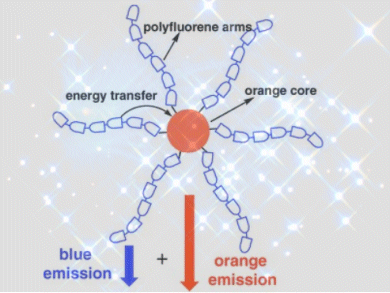Light-emitting diodes (LEDs) that produce white light can be made by coating a blue LED with phosphor or by mixing differently colored LEDs, which requires electronic circuits to control the blending of the colors. Phosphor-based LEDs are less efficient and degrade faster than other LEDs.
Zhiyuan Xie, Lixiang Wang, and co-workers, Chinese Academy of Sciences, have developed a star-shaped polymer that could be used in white LEDs. They incorporate six polyfluorene arms around a donor-acceptor type core. The simultaneous blue emission from the arms and orange emission from the core resulted in white electroluminescence with the highest efficiency reported for a single-polymer white LED. Core aggregation, and subsequent quenching, was prevented by the branched arms which makes the new polymers more effective than previous linear and star-shaped single-polymers.
Polymer-based white LEDs could overcome the efficiency problems seen with other LEDs and lead to their use in flat-panel displays or as low energy light sources.
Image: (c) Wiley-VCH
- White Electroluminescence from Star-like Single Polymer Systems: 2,1,3-Benzothiadiazole Derivatives Dopant as Orange Cores and Polyfl uorene Host as Six Blue Arms
L. Chen, P. Li, Y. Cheng, Z. Xie, L. Wang, X. Jing, F. Wang,
Adv. Mater. 2011.
DOI: 10.1002/adma.201100297

